


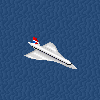
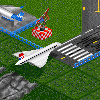
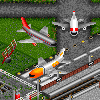



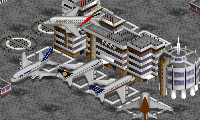
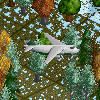

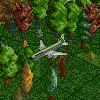
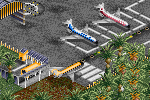

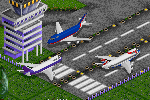

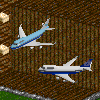






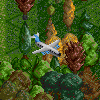

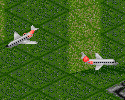
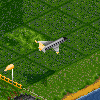
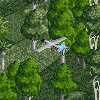

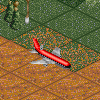
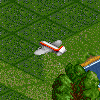


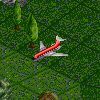

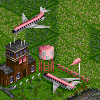
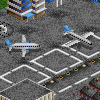
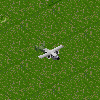
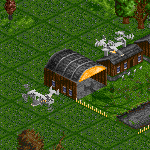
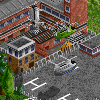


This is a complete list of the aircraft in the Planeset. Screenshots will be added shortly.
Work in progress may be found on the Tracking Table.
LZ-127 Zeppelin "Graf Zeppelin" | The LZ-127 "Graf Zeppelin" class airship was one of the great German airships. It first flew in 1928. The actual airship was dismantled in 1940 because of hydrogen-related security concerns after "Hindenburg" disaster. |
LZ-129 Zeppelin "Hindenburg" | The LZ-129 "Hindenburg" class airship was another great German airship. It first flew in 1936. The actual airship exploded in 1937 in hydrogen explosion caused by static spark. |
Aérospatiale-Alenia (ATR) ATR72 | The ATR72 is a highly-efficient regional turboprop plane that brings cost efficiency for short range routes. Together with its little brother ATR42 the series have met reasonable commercial success. ATR72 first flew for profit in 1989. |
Aérospatiale-BAC Concorde  | The Concorde is the only supersonic passenger airliner that has been in operation in western hemisphere. It was very expensive to develop and operate. Many airlines ordered it but canceled their orders because of the 1973 oil crisis. Eventually only Air France and British Airways kept their orders. Concorde planes were operated between 1976 and 2003. The Concorde only offers limited capacity for passengers and cargo despite its length. |
Airbus A300 (A300B2) | The Airbus A300 plane was the first product of the Airbus multinational group of European airplane manufacturers. It was aimed for short flights between big cities that need much passenger capacity. It was also the first twin-engine widebody jet, the planetype that nowadays dominates the big plane market because of its economy. At the beginning it suffered from poor sales but by the end of 70's it had become somewhat popular. First commercial A300 operations took place in 1974. |
Airbus A320 | During the 80's Airbus wanted their share of the 150-seat market with a twin-engine design. Initially they couldn't find suitable engines but eventually sufficiently-powered CFM56's became available. The A320 series, which was very advanced in terms of technology at the time of its introduction, is the bestselling Airbus with over 1500 sold (excluding A318, A319 and A321 figures), and it highly contributed to the later success of Airbus. First commercial A320 operations took place in 1988. |
Airbus A321 | The A321 is a stretched version of the A320. It started its operations in 1993. It's notorious for its below-average takeoff performance, especially in hot-and-high conditions. |
Airbus A340 (A340-300) | A more stretched variant of A340 with considerably more powerful engines was developed to compete with newer Boeing 777 models. With its length of 75.3m it is currently the longest passenger airliner in the world. Even with many passengers aboard, the A340-600 has good cargo capacity. Commercial operations began in 2002. |
Airbus A380 (A380-800) | When the Airbus A380 enters operation in 2006 or 2007, it will be the biggest passenger jetliner ever manufactured. However, its passenger figures can't outmatch Boeing 747EUD's until it (most likely) gets certified for more than 555 passengers in the future. The A380 beats Boeing 747 easily in size. Airbus promises A380 to have the lowest operating cost per passenger seat of any airliner. |
Antonov An-124  | The Russian-made "Ruslan" was the biggest jet aircraft in the world when it began its cargo operations in 1982. Its payload capacity is roughly the same as for A380 freighter version. This plane is very expensive to operate but if something big and heavy must be moved, the Ruslan is the weapon of choice. |
Boeing 707 (707-120) | The first American passenger jetliner to enter service in 1959. It competed with Douglas DC-8 and General Dynamic Convair 880/990 series and outsold them both with clear margin. Construction-wise it's the archetype of the modern-day jetliner, with underwing-mounted engines and fuselage/wing/tail configuration. As with any other early jetliner, B707 was very noisy but it brought the world closer for many people and contributed in making flying more accessible for the masses. Boeing 707 fuselage cross section was later utilized in B727, B737 and B757 models. |
Boeing 727 (727-100) | A smaller three-engine design to complement B707 family and a huge commercial success since its entry to commercial service in 1964. Boeing 727 was the most produced jetliner in the world when its production ended in 1984. Since then, only Boeing 737 and Airbus A320 family have surpassed the 727's production figures. |
Boeing 737 (737-100) | The Boeing 737 narrowbody twinjet is undoubtedly the best selling commercial jetliner in the world with thousands sold and more on order. It has seen considerable further development since its entry to service in 1968 including the 300/400/500 series of mid-80's and the NG series of the late 90's. The wide passenger capacity range of Boeing 737 series have caused the later models to replace 707, 727 and 757 in shorter-range service. |
Boeing 747 (747-100) | The "Jumbo Jet" was by a large margin the biggest passenger airliner in the world when it entered service in 1970. B747 was the first airliner to deploy the relatively silent high-bypass turbofan engines. The Jumbo Jet has stayed in production over various modifications. Like B707 earlier, the B747 made traveling by flying once again more accessible for people. |
Boeing 747 Extended Upper Deck (747-300)  | When the 747 was originally designed, Boeing thought that in passenger versions the short upper deck section would be used as a lounge. However, airlines mainly configured them for passengers to increase profit. In the early 80's, Boeing decided to stretch the upper deck to add slightly more passenger capacity and enhance the aerodynamics a bit. The Boeing 747-300 with stretched upper deck has been flying since 1983. Evolved versions have greater operating weights and more efficient revisions of engines that help profitability. |
Boeing 757 (757-200) | The smaller of the 757-767 twins that started its commercial ops in 1983. B757 was designed to replace some models of B707 and B727. Initially B757 sold worse than B767 but later 757 sales surpassed 767's. Its operating economics made it very popular for holiday charter companies and fuel consumption was greatly reduced from B727-200 and B707 models by the usage of two high-bypass turbofan engines. |
Boeing 767 (767-200) | The larger twin of the 757-767 twins was and is still the narrowest twin-aisle passenger aircraft ever built. Initial 767 model was much greater success than competing Airbus A310 while the later stretches, particulary the 767-300 model, have kept the 767 series popular. The commercial debut for 767 was in 1982. |
Boeing 777 (777-200) | The completely computer-designed Boeing 777 is an efficient long-range widebody that started its commercial service in 1995. As a heavyweight twinjet the Triple-Seven mounts the highest-powered turbofan engines in the market such as General Electric GE90's - an engine of B777-300ER is roughly the diameter of a B737 fuselage! |
Boeing 787 Dreamliner (787-3) | Boeing 787 Dreamliner will be Boeing's answer for the future long haul and high-capacity short range markets when it enters commercial service in 2008. A widebody highly similar in size with Airbus A330, it is able to carry a number of passengers over high distances. It will feature many advanced construction techniques like extended use of different plastics and fibres. |
Boeing Sonic Cruiser | The Boeing Sonic Cruiser was a concept plane in early 2000's to probe customer interest for future long-range airplane that would travel in transsonic velocities, slightly faster than current jets. It didn't gain much attention from airlines and Boeing opted for building the 7E7 Dreamliner instead. Japan's interest towards an airplane making connections to USA faster than current planes may see this plane in flight around the year 2016. |
Bombardier CRJ-700 | The CRJ-700 is a stretched development of Canadair CRJ-100/200 regional jets. It started commercial operations in 2001. |
British Aerospace BAe146 (BAe146-200) | BAe146 is a British short-range regional jetliner that features four engines, short takeoff and landing distances and low noise level. It was the first commercial jetliner that was certified for the London City Airport. Initially the BAe146 series were a success but later its mediocre economic efficiency made it an inferior choice vs. Canadair/Bombardier and Embraer regional jets. However, its flight performance is much better, and there are many airports in mountainous terrain or restricted areas where only the BAe146 can provide service. BAe146's first commercial ops were in 1983. |
De Havilland Comet (Early model) | DH Comet was the first commercial jetliner ever to enter commercial service in 1952. Its speed was unparallered in the early 50's. However, its square windows caused then-unknown phenomenon of metal fatigue in pressurized fuselages. Many Comets mysteriously crashed around two years after the beginning of operations having only several thousand flying hours on them. These problems were eventually figured out but at the time improved Comets were rolling out Boeing 707 was already selling well, and the Comet never became commercially successful. |
Embraer ERJ-145 | Embraer ERJ-145 is a small regional jetliner for the 50-seat market. It has been a great sales success ever since its introduction and has sold hundreds of frames especially to North America and Europe. ERJ-145's entry into service occured in 1996. |
Embraer 190 | Embraer 190 is the answer of this Brazilian company against the highly-competed regional jetliner market against Boeing 717, CRJ series and the aging Fokker 70/100 and BAe146/Avro RJ models. It looks like a little brother of modern long-range designs. Its commercial operations are expected to begin in 2005. |
Fokker F-27 (Also represents Fokker 50 in the game) | Fokker F-27 "Friendship" is an early regional turboprop plane. Some sources have said that Fokker F-27 was the plane that came closest to be the DC-3 replacement. It accumulated impressive manufacturing figures during its long manufacturing run. First Fokker F-27 revenue flights took place in 1958. |
Lockheed L-049 Constellation | This American postwar propliner with its funky shape was one of the more successful passenger airplanes at that time. "Connie" ops started in 1946. |
Lockheed L-1011 Tristar (L1011-1) | Lockheed's direct competitor for the DC-10 was quite similar in operational specifications. The start for L-1011 Tristar ops was delayed by severe financial difficulties at Rolls-Royce, the developer of Tristar's RB211 powerplants, eventually taking place in 1972. Although DC-10 had its own difficulties, Tristar couldn't outsell it. After the poor sales of the Tristar, Lockheed decided to withdraw from the commercial airliner market. |
Douglas DC-3 "Dakota" | This pre-WW2 design which started its commercial operations in 1935 was one of the first airplanes not made from wood but metal instead. During the WW2, a vast number of DC-3/C-47's were used as military transports. After the war many of them were converted to carry passengers, and most passenger fleets at that time operated the DC-3. No commercial aircraft in the world could match or come even near Douglas DC-3's production figures. Many DC-3s were still in revenue service at the beginning of the 21st century. |
Douglas DC-6 (DC-6B) | This four-motor long range propliner started its operations in 1947 and was one of the first airplanes to perform transatlantic flights (with technical stops, however). |
Douglas DC-8 Super stretched (DC-8-61) | In mid-60's the sales of DC-8 series went down while at the same time B707 sold very well. Douglas decided to stretch the DC-8 airframe to give more life for the type. Resulting aircraft were the Super 60 series, of which models 61 and 63 were the biggest commercial jetliners before the 747 era. The first Super 61 started its operations in 1966. DC-8's became unpopular in passenger traffic by the arrival of widebodies in early 70's but its good cargo carrying capacity combined with ridiculously durable airframe and later CFM56 program have given it an unparalleled lifetime when it comes to commercial jetliners. |
McDonnell Douglas DC-9 (DC-9-10) | Douglas Commercial decided to design a smaller brother for its DC-8. This new model was to be smaller than any existing Boeing model. DC-9 and its numerous derivatives such as MD-80 series and Boeing 717 became the definite bestseller of McDonnell Douglas. The DC-9 has been a dependable workhorse for many short-range, low capacity lines since its commercial debut in 1965. |
McDonnell Douglas DC-10 (DC-10-10) | The DC-10 was a successful plane to fill the market niche between DC-8 Super 60 and 747 series. The reputation of DC-10 suffered from several bad total hull loss accidents in 70's but eventually it improved. DC-10 and its later derivative, the MD-11 have been highly praised as cargo airplanes. DC-10 ops started in 1971. |
McDonnell Douglas MD-80 (DC-9-81) | The MD-80 series planes, originally known as DC-9 Super 80 series, were a lenghtened and upgraded brothers for the original DC-9 series. Just as the original DC-9 series, these planes have been a backbone for many airlines' fleets since their first commercial flights in 1981. |
Saab 2000 | Saab 2000 was a lenghtened but unfortunately unsuccessful brother for Saab-Fairchild SF340 turboprop. It features one of the highest airspeeds ever for a commercial propeller-driven aircraft. Saab 2000 has flown in limited numbers since 1994. |
Shorts 330 | The Shorts 330 is a small short-range regional propliner. It started operations in 1976. |
Bell V-22 Osprey | The Osprey is an interesting military-originated aircraft that can fly like a regular airplane but takeoff/land vertically like a helicopter because of its engine/rotor configuration. Economical feasibility of commercial Osprey operations is questionable but in the Planeset it is available for purchase starting from game year 2004. |
Boeing Commercial Chinook | The Chinook is one of the biggest helicopters in the western hemisphere. It was originally designed as a troop transport but later it was used in some oil rig passenger operations. Chinook commercial ops began in 1981. |
Eurocopter AS-332 Super Puma | The Super Puma is a French-made medium-sized helicopter. First flight took place in 1978. |
Sikorsky S-61 | The S-61 is an American-made medium-sized helicopter. First flight of the commercial version occurred in 1961. |